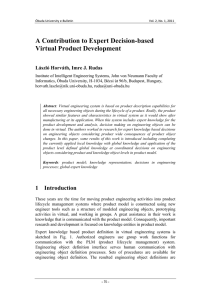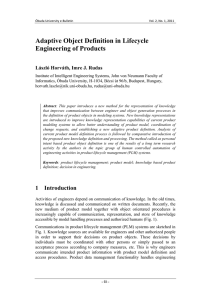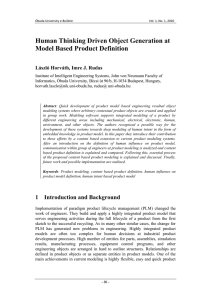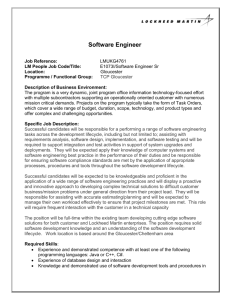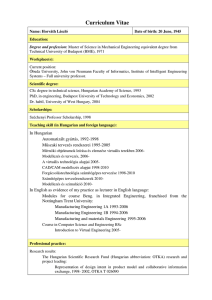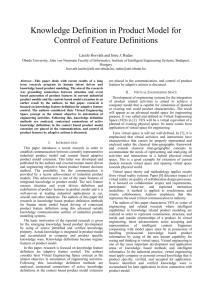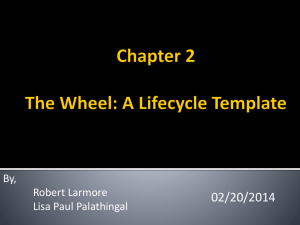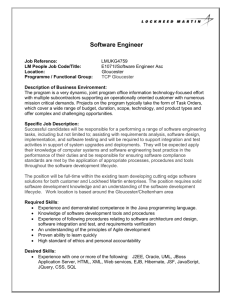Individual Engineer Knowledge Controlled Lifecycle Product Definition László Horváth, Imre J. Rudas
advertisement
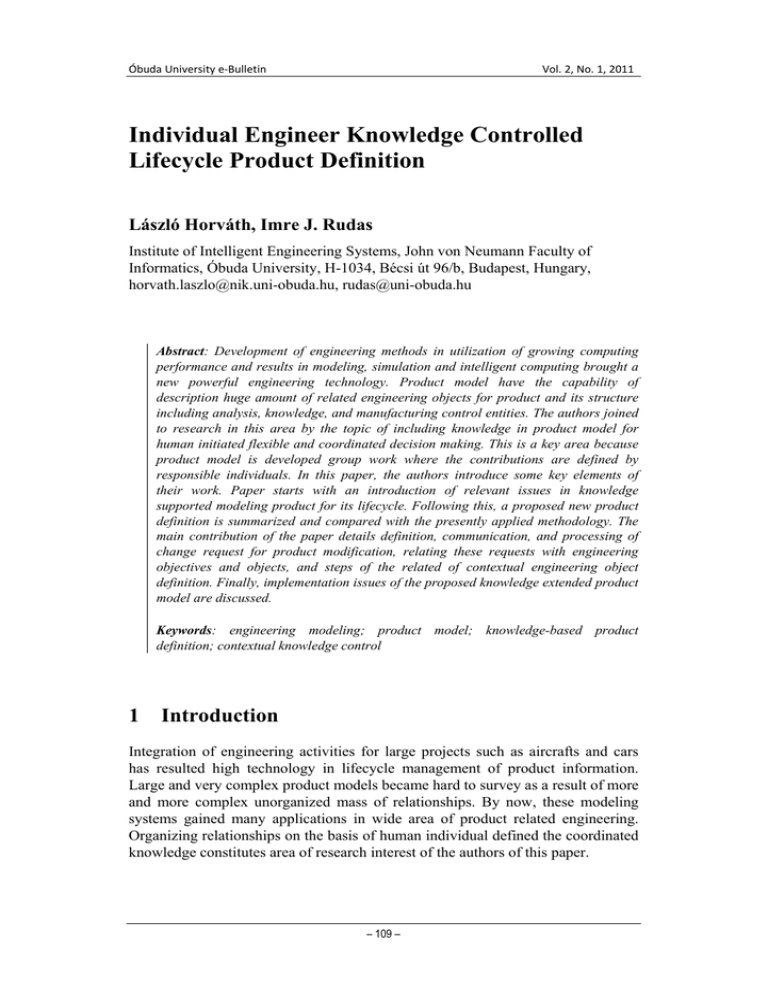
Óbuda University e‐Bulletin Vol. 2, No. 1, 2011 Individual Engineer Knowledge Controlled Lifecycle Product Definition László Horváth, Imre J. Rudas Institute of Intelligent Engineering Systems, John von Neumann Faculty of Informatics, Óbuda University, H-1034, Bécsi út 96/b, Budapest, Hungary, horvath.laszlo@nik.uni-obuda.hu, rudas@uni-obuda.hu Abstract: Development of engineering methods in utilization of growing computing performance and results in modeling, simulation and intelligent computing brought a new powerful engineering technology. Product model have the capability of description huge amount of related engineering objects for product and its structure including analysis, knowledge, and manufacturing control entities. The authors joined to research in this area by the topic of including knowledge in product model for human initiated flexible and coordinated decision making. This is a key area because product model is developed group work where the contributions are defined by responsible individuals. In this paper, the authors introduce some key elements of their work. Paper starts with an introduction of relevant issues in knowledge supported modeling product for its lifecycle. Following this, a proposed new product definition is summarized and compared with the presently applied methodology. The main contribution of the paper details definition, communication, and processing of change request for product modification, relating these requests with engineering objectives and objects, and steps of the related of contextual engineering object definition. Finally, implementation issues of the proposed knowledge extended product model are discussed. Keywords: engineering modeling; product model; knowledge-based product definition; contextual knowledge control 1 Introduction Integration of engineering activities for large projects such as aircrafts and cars has resulted high technology in lifecycle management of product information. Large and very complex product models became hard to survey as a result of more and more complex unorganized mass of relationships. By now, these modeling systems gained many applications in wide area of product related engineering. Organizing relationships on the basis of human individual defined the coordinated knowledge constitutes area of research interest of the authors of this paper. – 109 – L. Horváth, I. J Rudas Individual Engineer Knowledge Controlled Lifecycle Product Definition Product lifecycle management (PLM) is served by extensive functionality in current industrial engineering systems [1]. Product prototyping activities are being moved from physical tests to experiment plan based extensive and complex simulations in order to achieve better results and decrease time and cost. This new engineering technology strongly depends on representation of engineering knowledge in the product model. Knowledge supports product object definition, and active and passive simulations. Passive simulation produces results for human consideration while active simulation controls the definition of product objects. Figure 1. Model definition for product Model definition for product is briefed in Fig. 1. Object definition by engineer in dialogue is initiated by engineer request. It consists of authorization control, – 110 – Óbuda University e‐Bulletin Vol. 2, No. 1, 2011 selection of object, selection and definition of contexts, definition of engineering object parameters. The communicated request drives generating the requested objects for product model. Work in product modeling by the authors of this paper relies upon the recent advances in product lifecycle management (PLM). PLM is considered as a new paradigm to manage products all the way across their lifecycles in the most effective way that demands highly organized information system [9]. The previous work by the authors is based on three main recognitions. The first is to enforce well-defined human intent at product definition [2]. Authorized and responsible humans are sources of knowledge representing experience, expertise, skill, and intelligence. This knowledge must be accepted in the relevant company environment. Contradicting intents must be coordinated even at a single decision during engineering object definition. The second recognition is product object definition which serves well-defined engineering objectives [3]. The third recognition is control of object definition by adaptive action [4]. Adaptive action carries change information that is concluded from coordinated human intents in a change affect zone (CAZ) [5]. The results in this paper were selected to introduce in the form of oral talk on the IECON 2011, the 37th Annual Conference of the IEEE Industrial Electronics Society, Melbourne, Australia, held in 2011 November [12]. This annual conference is the main event of the IEEE Industrial Electronic Society with worldwide participation of internationally recognized leading researchers. Year 2011 is the 60th Anniversary of the IEEE Industrial Electronics Society and the conference focuses on industrial and manufacturing theory and applications of electronics, controls, communications, instrumentation and computational intelligence. One of the purposes of the talk was to join to this focus theme. In this paper the authors introduce some key elements of their work. Paper starts with an introduction of relevant issues in knowledge supported modeling product for its lifecycle. Following this, a proposed new product definition is summarized and compared with the presently applied methodology. The main contribution of the paper details definition, communication, and processing of change request for product modification, relating these requests with engineering objectives and objects, and steps of the related of contextual engineering object definition. Finally, implementation issues of the proposed knowledge extended product model are discussed. 2 Knowledge Supported Product Definition It is and old problem to model and simulate knowledge in order to definition, communication and processing in groups of engineers. This is the general – 111 – L. Horváth, I. J Rudas Individual Engineer Knowledge Controlled Lifecycle Product Definition objective of the authors in research on virtual engineering. General schema of product definition in model based engineering systems is shown in Fig. 2. Authorization and responsibility of human are verified according to locally accepted rules and well-defined human roles. Area of the research reported in this paper covers engineering activities, product object definition and application processes, as well as product structure and entity representation. Figure 2. Modeling for lifecycle of product Product object definition and application processes are available for human in order to facilitate engineering activities during lifecycle of product. Product – 112 – Óbuda University e‐Bulletin Vol. 2, No. 1, 2011 structure representation connects model entities in product. Lower level structures in a product model structure may serve, for example, topology for shape representation or analysis management. Engineering object representations support description of product entities in product model. Results of product object definition are processed by authentication, group communication, project management, and product data management functionalities. Product model for lifecycle of a product, may serve a group of products, a line of products, or all products in an organization. Integrated engineering modeling requires wide area for research. Information to be included in product model can be organized by information modeling. In [6], an IDEF1 process oriented information modeling methodology is proposed for easy identification and analysis of information requirements. In [7], construction history, parameters, constraints, features and other elements of design intent are analyzed and implementation of product model data exchange with the preservation of design intent is proposed, based on the use of newly published parts of the International Standard ISO 10303 (STEP). 3 Current and the Proposed Product Definition Engineer defines product objects by using of communication tools in a PLM system controlling object feature generation processes by specifications for object parameter values, procedures for object definition, and contextual objects. This modeled object is placed in model structure. In order to facilitate easier modification of the model for new situations and events, active rules and reactions are included in the product model in order to control engineering objects. However, all of the above representations have only capability for record the decisions. One of the problems with this capability is that the way to the decisions cannot be recorded. Other problem is that requests by different authorized and other persons are not recorded in the model for late change in case of different situations. Engineer who applies a model can not be informed about intent of original decision makers so that modification of objects requires re-definition by engineers without original equations, optimizing algorithms, etc. those are not available in the product model. In order to improve this situation, recent developments for engineering systems aimed at new knowledge representations in product models. As a result, human influence on engineering activities at product definition in current modeling systems is assisted by definition of new knowledge and application of accepted knowledge (Fig. 3). For industrial application purpose, verification and acceptance of knowledge are necessary. Experts emphasize personal and organizational characteristics of knowledge. A method is proposed – 113 – L. Horváth, I. J Rudas Individual Engineer Knowledge Controlled Lifecycle Product Definition for handling of these knowledge characteristics in engineering processes in [11]. In these modeling systems, engineering object definition can be done by the conventional direct human control or by knowledge. Knowledge based modeling in Fig. 3 is suitable for formal description of calculation methods for product object parameters. Equations, optimizing algorithms, etc. are available in product model for re-definition or modification of formerly defined product objects in order to fit product definition to changed circumstances. However, the way to results is still not recorded and the engineer who applies the model is not informed about intent of original decision maker. The authors analyzed this problem and proposed a new modeling (Fig. 4) as a contribution its future solution in PLM systems. Figure 3. Current product definition In the engineering object definition proposed by the authors of this paper, human influence on engineering activities for lifecycle of product is realized by the entity change request for new or modified engineering objects (Fig. 4). Human also defines background knowledge for realization of the change request. Background knowledge is processed during coordinated decision making on engineering objects. In this modeling, engineering object definition is controlled by using a – 114 – Óbuda University e‐Bulletin Vol. 2, No. 1, 2011 new entity for adaptive action. Exceptionally, conventional direct control can be allowed under special responsibility of authorized engineer. Figure 4. The proposed product definition Processing of change request for new or modified engineering objects is detailed in Fig. 5. Although human influence through change request is defined by engineering project members, decisions from upper level makers, as well as relevant effective law and standards are mandatory to accept and consider. – 115 – L. Horváth, I. J Rudas Individual Engineer Knowledge Controlled Lifecycle Product Definition Figure 5. Processing change request – 116 – Óbuda University e‐Bulletin Vol. 2, No. 1, 2011 At the same time, these affects can be argued in accordance with company and governmental rules. Recent modeling systems increasingly offer capabilities for representation experience and expertise in the form of stored knowledge. The proposed modeling applies these representations at definition of change request. Change requests and the accompanying knowledge support are acquired in the course of special dialogue. Any change request must be accompanied with engineering objectives. Engineering objectives are organized and coordinated. Change requests and engineering objectives are mapped to existing and change request initiated product objects. Product object representations are created in the course of processing the accompanying knowledge considering contextual connection definitions (Fig. 5). Figure 6. Communicating process of change request Processing the accompanying knowledge serves creation adaptive action entities. In order to evaluate and coordinate change requests for a product object, change affect zone [3] is defined as set of potentially affected product objects. Contextual – 117 – L. Horváth, I. J Rudas Individual Engineer Knowledge Controlled Lifecycle Product Definition chains are defined and integrated in change affect zone. Decision on change requests and consequence changes results accepted changes including consequence changes and adaptive actions. Generation of product object parameters is controlled by adaptive actions. Human influence through acquired change request and knowledge support is detailed in Fig. 6. Influence through change request is defined for target behaviors and target objects. Behavior is model representation of engineering objective. Record of way to change request in the mind of engineer includes steps of way in the form of human thinking process elements and object definition in the form of a series of interim decisions. Acquired change request entities are mapped to product objects and the related other engineering objects. The problem of human interfacing is complex because of the need for coordination of intent from several humans for the same decision. In [8] multiple expert inputs in knowledge learning were processed by application Bayesian Network to structure definition and empirical data to refinement and parameterizations of that structure. 4 New Entities for Extension of Product Model PLM system is capable of given sets of representations in the form of entities available for the model construction. Modeling by the authors should be based on an extension to these sets. Because the new entities in the proposed modeling serve representation of engineering object related knowledge, they must be mapped to product and other engineering objects by using of rectangular spaces (Fig. 7). Chain of contextual entities is mapped to chain of contextual spaces. Influence space connects influencing humans with influenced product objects. In this context, humans who influence through stored experience and expertise are also handled as influencing humans. Entities represent authentication and strength of influence. Change requests are identified. Intent space connects recorded human intent with product objects. Entities represent status of intent, purpose of intent, steps of way to the change request, and definition of product and other related engineering objects including engineering objectives. Behavior space connects behaviors and the accompanied situations with product objects. Situations composed by engineering object parameters and engineering object based behaviors are represented in entities. Decision space connects decision related entities with engineering objects for which decisions are made. Contextual graph entity includes nodes to represent product object and edges to represent contextual connection between two product – 118 – Óbuda University e‐Bulletin Vol. 2, No. 1, 2011 objects. Contextual chains and change affect zone are designated in the contextual graph. Adaptive action carries the requested, coordinated, and decided change of engineering objects. Figure 7. New entities and their mapping to product objects – 119 – L. Horváth, I. J Rudas Individual Engineer Knowledge Controlled Lifecycle Product Definition Figure 8. Steps of contextual engineering object definition – 120 – Óbuda University e‐Bulletin Vol. 2, No. 1, 2011 The proposed new model entities are applied at product object definition according to the process in Fig. 8. Emphasis of new product definition is on context of human that is represented in the product model. Authentication of human informs about the type and weight of human influence. Personalization and codification have high attention especially in development of multidisciplinary frameworks [10]. The example “Designer with normal weight” means that engineer is authorized for the actual product object definition with mandatory restrictions and the result will be undergone normal acceptance procedure. Consequently, status of intent is proposal and purpose of intent is development of construction. Engineer defines product objects while steps on the way to result and partial decisions are recorded in the intent model. In the example of Fig. 8, steps on the way are making specification, conceptual definition of object, and calculation of object parameters. Partial decisions in object definition are made for engineering objectives, selection of object, and calculation methods for object parameters. The next step in product object definition is definition of behavior entities on the basis of engineering objectives. Behavior should be defined in a way that is suitable for evaluation of fulfilling the function and quality criteria in specification. For this purpose, situation is defined including parameters affecting behavior of the defined object. At this point, change request information and situation information are available for targeted engineering objects and behaviors. Change request includes methods for the definition of engineering objects in some form of knowledge. Change request also includes targeted engineering objectives. At the same time, it is allowed not to include methods for the definition of engineering objects when engineering objectives are fulfilled by other change requests. Built in procedures may be applied in the modeling system as library change requests for accepted automatisms. Process of coordination of change requests and definition of executable adaptive actions during decision on engineering object parameters was detailed and explained in [4]. 5 Knowledge Extended Product Model Feasibility of the proposed modeling is based on the capabilities of recent PLM systems to accommodate product and company specific knowledge in product model. When these capabilities are not suitable for some new knowledge and its processing, software development libraries are available in the form of application – 121 – L. Horváth, I. J Rudas Individual Engineer Knowledge Controlled Lifecycle Product Definition programming interface (API). Some of application developments are included in the standard PLM functionality after practical evaluation. Figure 9. Extending current product model – 122 – Óbuda University e‐Bulletin Vol. 2, No. 1, 2011 Figure 10. Extended object definition – 123 – L. Horváth, I. J Rudas Individual Engineer Knowledge Controlled Lifecycle Product Definition The proposed modeling is devoted to be a main step in future developments towards better human control and at the same time extended and organized representation and application of knowledge. PLM systems require relative simple, transparent and generalized procedures those are best fit to the wellproven current product definition practice. This is the main objective of the authors in the human intent driven adaptive action based product definition. The proposed extension to currently applied product modeling can be followed in Fig. 9. Currently applied modeling systems consist of model for engineering objects, parameters and relationships, object modeling environment for object definitions, parameters and procedures, and product modification features for application definition, model definition and representation. Generation of engineering objects in product model for lifecycle is done according to control on human communication surface. Extended object definition for the extending current product model is outlined in Fig. 10. Modeling tools available for contextual object definition in a PLM system include knowledge definition, product object definition, product object structure, and user interaction surface kits. Main connections of object management are product data management handling product data base, and application programming interface (API) for application development of the PLM system. API connected extensions for the proposed modeling include mapped contextual objects, their mapping to engineering object in the PLM system to be extended, and procedures for new product model entities proposed by the authors of this paper. Conclusions and Future Plans This paper introduced some key elements from the results by the authors in individual engineer defined knowledge based definition of engineering objects in PLM systems. These elements are definition, communication, and processing of change request for product modification, relating these requests with engineering objectives and objects, and steps of the related of contextual engineering object definition. The proposed modeling offers a new way for object definition during product definition by modeling. Human influence on engineering activities at product definition in modeling systems is assisted by definition of new knowledge and application of accepted knowledge. Human defines background knowledge for realization of the change request. Engineering object definition is controlled by using a new entity for adaptive action. Engineering objectives are organized and coordinated. Change requests and engineering objectives are mapped to existing and change request initiated product objects. Product object representations are created in the course of processing the accompanying knowledge considering contextual connection definitions – 124 – Óbuda University e‐Bulletin Vol. 2, No. 1, 2011 Future plans in the reported research are determined by need for model entities best fit to sets of PLM system entities. A main task is definition of the chain consisting of engineering objective, product behavior, and adaptive action entities as supported by change request and accompanying knowledge. Acknowledgement The authors gratefully acknowledge the grant provided by the Óbuda University. References [1] L. Horváth and I. J. Rudas, Modeling and Problem Solving Methods for Engineers , Elsevier, Academic Press, New York, etc., 2004, p. 330 [2] L. Horváth and I. J. Rudas, “Human Intent Representation in Knowledge Intensive Product Model,” Journal of Computers, Vol. 4 No. 9, pp. 954961, (2009) [3] L. Horváth, I. J. Rudas, “Engineering Objective Driven Product Lifecycle Management with Enhanced Human Control,“ In book Towards Intelligent Engineering and Information Technology, in Series: Studies in Computational Intelligence, Vol. 243, Springer-Verlag, Berlin, Heidelberg, 2009, pp. 543-556 [4] L. Horváth, I. J. Rudas, “Adaptive Modeling for Robot Systems Based on Behaviors and Feature Driven Shape Descriptions,” WSEAS Transactions on Information Science and Applications, ISSN 1790-0832, 2(11), 17611771, (2005) [5] L. Horváth, I. J. Rudas, “Processes for Improved Human Control over Definition of Product Models,“ in Proc. of The 35th Annual Conference of the IEEE Industrial Electronics Society, Porto, Portugal, 2009, pp. 24912496 [6] P-H. Chen, C. Wana, R. L. K. Tionga, S. K. Tinga and Q. Yangb, “Augmented IDEF1-based process-oriented information modeling,” in Automation in Construction, Volume 13, Issue 6, pp. 735-750 (2004) [7] G. R. Iyer, J. J. Mills, S. Barber, V. Devarajan and S. Maitra, “Using a Context-based Inference Approach to Capture Design Intent from Legacy CAD,” Computer-Aided Design & Applications, Vol. 3, Nos. 1-4, pp 269278 (2006) [8] M. Richardson, P. Domingos, “Learning with Knowledge from Multiple Experts,” in proc. of the Twentieth International Conference on Machine Learning, Washington, DC, Morgan Kaufmann, pp. 624-631 (2003) [9] J. Stark, Product Lifecycle Management: 21st Century Paradigm for Product Realisation, Birkhäuser, 2004, p. 441 – 125 – L. Horváth, I. J Rudas Individual Engineer Knowledge Controlled Lifecycle Product Definition [10] C. McMahon, A. Lowe and S. Culley, “Knowledge management in engineering design: personalization and codification,” Journal of Engineering Design, Volume 15, Number 4, pp. 307–325 (2004) [11] Y. Kitamura, M. Kashiwase, M. Fuse, R. Mizoguchi, “Deployment of an ontological framework of functional design knowledge,” Advanced Engineering Informatics, (18)2, 115-127 (2004) [12] L. Horváth and I. J. Rudas, ”Integrated Modeling for Corporate KnowledgeControlled Lifecycle Product Definition,” in proc. of the IECON 2011, the 37th Annual Conference of the IEEE Industrial Electronics Society, Melbourne, Australia, 2011, in press – 126 –
